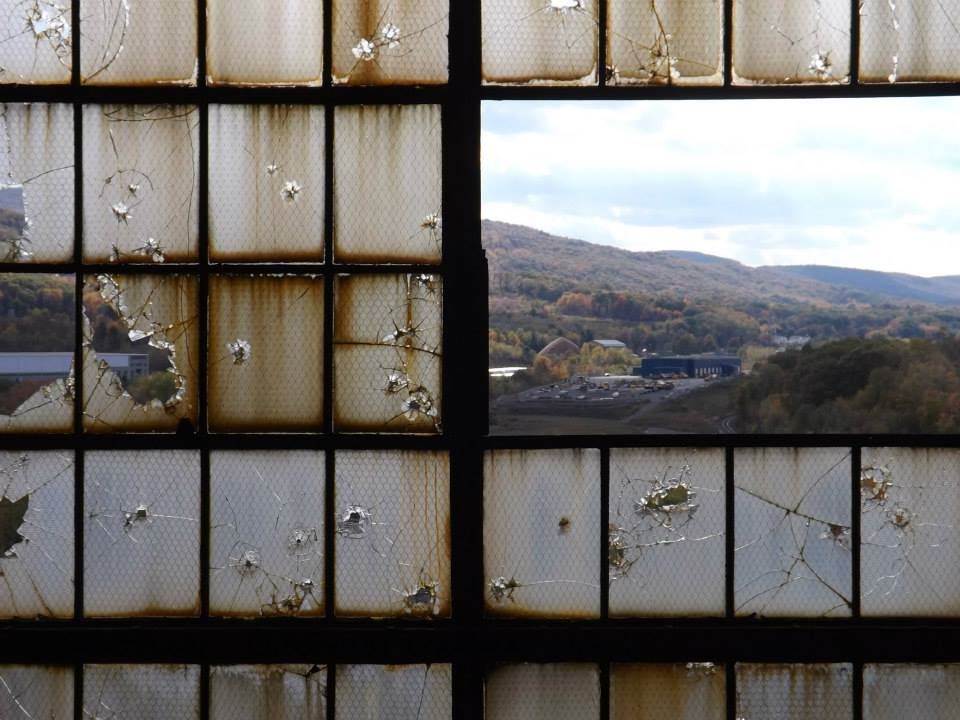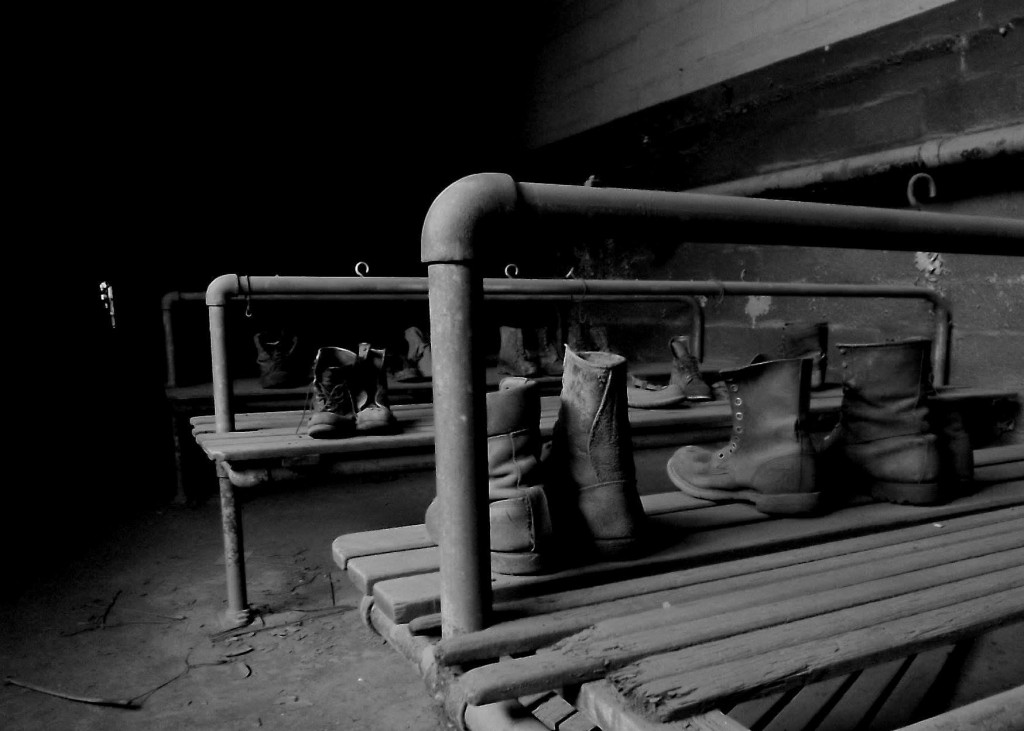by Gabby Zawacki
Drive through Northeastern Pennsylvania and you may see black hills of coal and orange water flowing near or through towns. What you’re witnessing is the legacy of historic anthracite coal mining, which fueled the USA’s industrial revolution and two world wars, had extremely dangerous labor practices, and lead to the destruction of its landscape. Diverse hardwood forests filled with wildlife were replaced with black mountains of coal waste with acidic soil that can only support birch trees, briar bushes, and scrub vegetation. Thriving cold-water fisheries were replaced with abandoned mine drainage (AMD), orange water devoid of oxygen and all aquatic life.
While mining issues are gaining national attention since the 2015 Gold King mine spill in Colorado, Pennsylvania sometimes seems like the forgotten state despite having more mining issues than any other state in the nation.
Anthracite mining once fueled the region’s economy, but after coal companies began to go bankrupt, once-thriving towns were left with nothing but devastated land & water and the scattered spines of abandoned coal breakers & mine shafts. Land reclamation projects and AMD treatment systems help to alleviate some of these problems, but these solutions are often expensive. While mining issues are gaining national attention since the 2015 Gold King mine spill in Colorado, Pennsylvania sometimes seems like the forgotten state despite having more mining issues than any other state in the nation. Perhaps it’s the fact that our mining heritage is in the past, while many other states continue to have active mineral and hardrock mining, allowing their issues to be more present.

The black hills of coal are more commonly known as culm piles. These piles are created by dumping coal waste, such as rock and shale, after separating it from the valuable anthracite coal. While these piles are large, they represent approximately 50% of what was taken out of the ground, revealing the massive size of mining voids lying beneath Pennsylvania’s valleys.
Land reclamation generally involves bringing the land back to a natural contour, adding a layer of topsoil to encourage vegetation, and seeding the land in order to begin the reclamation process.
Land reclamation projects are mostly funded through state and federal grants, with EPA Brownfield Grants and PA Department of Environmental Protection Growing Greener grants allowing non-profits to help recover devastated landscapes. Land reclamation generally involves bringing the land back to a natural contour, adding a layer of topsoil to encourage vegetation, and seeding the land in order to begin the reclamation process. While this process is straight-forward, mining pits can be incredibly steep, making the reclamation process take longer and be more costly.

AMD, or abandoned mine drainage, is another legacy of past mining. AMD flows from mine openings and drilled boreholes to relieve pressure from the underground mine pools. AMD forms when water reacts with pyrite, or ‘fool’s gold’, deep in the underground abandoned mine workings.
As pyrite is exposed to water and oxygen, the sulfides within the rock react and break down to form sulfuric acid and iron oxide. Other metals and minerals within the rock can also become exposed and pollute the water, with many discharges in PA and other states containing heavy metals such as iron and aluminum, and some discharges containing trace amounts of harmful metals such as lead and arsenic.

To put this into perspective, many mines were 500-1000 feet deep, with some mine shafts reaching approximately 2000 feet in depth. Like digging a hole in the sand at the beach, at a certain point water will keep filling the hole no matter how much you try to keep it out. It’s the same with mine water. Once mining companies hit the water table, they would always have to pump water out of the mines, continually increasing the cost to produce anthracite coal. After all of the coal companies went bankrupt, along with historic events such as the Knox Mine Disaster in 1959 and the Historic Agnes Flood of 1972, deep mining ended in most parts of the Coal Region.
The Knox Mine Disaster occurred on January 22, 1959 when the Knox Coal Company drilled within 20 feet of the Susquehanna River bottom. The immense water pressure caused the mine to collapse, creating a whirlpool that filled miles of underground tunnels with water. 12 miners died in the tragedy.
The Knox Mine Disaster occurred on January 22, 1959 when the Knox Coal Company drilled within 20 feet of the Susquehanna River bottom. The immense water pressure caused the mine to collapse, creating a whirlpool that filled miles of underground tunnels with water. 12 miners died in the tragedy. The disaster highlighted the dangers of irresponsible mining practice, with the ultimate consequence being the flooding of honeycombed mine workings throughout the Wyoming Valley causing working mines to be inundated with water, effectively ending the already struggling anthracite coal industry.
By the Agnes Flood of 1972 in which the Susquehanna River rose 40 feet and devastated the Wyoming Valley, most mining companies had claimed bankruptcy and as the pumps removing water were shut off, mine water began to spill out of any available opening leaving streets, basements, and streams filled with polluted mine water.
Furthermore, because mining companies were not required to treat abandoned mine drainage or reclaim mining land, once a company went bankrupt, the burden fell on taxpayers and government organizations to clean up the mess. Present-day active companies are required to reclaim land and treat any AMD discharges caused by their mining.



In Pennsylvania, AMD occurs in the Anthracite Region in the Northeast and the Bituminous Region in Western PA. In the Northern Anthracite fields, most AMD discharges have heavy concentrations of iron with relatively neutral pH’s around 6.5, the same pH as normal rainfall. In the Middle & Southern Fields and the Bituminous Region, discharges tend to be more acidic (4 pH) with heavy concentrations of aluminum. Treatment systems help remove AMD and restore water quality. There are 2 types of treatment, active and passive. Active treatment refers to the use of added components such as chemicals (limestone) and machinery (oxygenation machines and automatic chemical dosers) to treat AMD.
Overall, treatment systems are expensive to install and even after successful installation, long-term upkeep can become difficult to fund and maintain.
In general, active systems are more costly and require electricity and regular maintenance to remain efficient. Passive treatment refers to the use of natural settling in large ponds for oxygenation as well as natural growth of wetland plants to treat AMD. Passive methods include settling ponds and using gravity to move water through a treatment system. These systems are usually more cost effective and don’t have many long term maintenance or operation costs. Overall, treatment systems are expensive to install and even after successful installation, long-term upkeep can become difficult to fund and maintain.
While this pollution problem will take a lot of effort to remediate, dedicated watershed associations, local conservation districts, and environmental non-profits are working to fix this problem by installing treatment systems, restoring streams, and educating the public about this issue through community events such as illegal dump cleanups on minelands and environmental education projects with community organizations and local school districts.
Pennsylvania’s legacy of abandoned minelands and AMD have implications nationally as well as globally. While clean energy is an important goal to achieve in order to help move towards a new era of environmental stewardship, coal mining communities need to be supported in the form of mineland and AMD clean-ups as well as economic stimulation in order to successfully move towards a better future.
Pennsylvania’s mine land issues are a vast, far-reaching, and expensive problem. The effect can be seen nationwide, with other coal states such as Wyoming, Kentucky, West Virginia, and Illinois facing the same issues. Hardrock mining states also face similar issues, as seen with the Gold King Mine disaster in Colorado. Globally, countries like China, India, and Australia are just beginning to produce mass amounts of coal. Pennsylvania’s legacy of abandoned minelands and AMD have implications nationally as well as globally. While clean energy is an important goal to achieve in order to help move towards a new era of environmental stewardship, coal mining communities need to be supported in the form of mineland and AMD clean-ups as well as economic stimulation in order to successfully move towards a better future. Pennsylvania’s struggles can serve as an example for other communities throughout the United States and developing industrial countries.

All photos by Gabby Zawacki.
Gabby Zawacki is a Watershed Outreach Specialist for the Eastern Pennsylvania Coalition for Abandoned Mine Reclamation (EPCAMR), an environmental non-profit in Northeastern Pennsylvania. In her free time she enjoys hiking, mountain biking, kayaking, traveling, and photography.
http://epcamr.org/home/ | https://www.facebook.com/EPCAMR | http://www.earthconservancy.org/ | http://www2.datashed.org/ | https://www.epa.gov/polluted-runoff-nonpoint-source-pollution/abandoned-mine-drainage
To receive our next article by email, click here.
